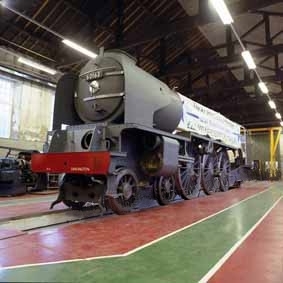| ET7 | |||||||||||||||||||
|---|---|---|---|---|---|---|---|---|---|---|---|---|---|---|---|---|---|---|---|
 The Polish T2D, which was very similar to the ET7 class. | |||||||||||||||||||
| |||||||||||||||||||
| |||||||||||||||||||
| |||||||||||||||||||
| |||||||||||||||||||
The China Railways ET7 class of locomotives were a series of 90 0-8-0T machines for industrial use built by Fablok of Poland.
| ET7 | |||||||||||||||||||
|---|---|---|---|---|---|---|---|---|---|---|---|---|---|---|---|---|---|---|---|
 The Polish T2D, which was very similar to the ET7 class. | |||||||||||||||||||
| |||||||||||||||||||
| |||||||||||||||||||
| |||||||||||||||||||
| |||||||||||||||||||
The China Railways ET7 class of locomotives were a series of 90 0-8-0T machines for industrial use built by Fablok of Poland.
90 locomotives were built and exported to China between 1959 and 1961 for use on industrial sites, including steelworks. [1] Many units were still in work in the 1980s and some of the machines remained in use until the 1990s. [1] [2]
ET7-5333 is preserved at Baotou Museum.

0-6-0 is the Whyte notation designation for steam locomotives with a wheel arrangement of no leading wheels, six powered and coupled driving wheels on three axles, and no trailing wheels. Historically, this was the most common wheel arrangement used on both tender and tank locomotives in versions with both inside and outside cylinders.

The first Locomotives of the Great Western Railway (GWR) were specified by Isambard Kingdom Brunel but Daniel Gooch was soon appointed as the railway's Locomotive Superintendent. He designed several different 7 ft 1⁄4 in broad gauge types for the growing railway, such as the Firefly and later Iron Duke Class 2-2-2s. In 1864 Gooch was succeeded by Joseph Armstrong who brought his standard gauge experience to the workshops at Swindon. To replace some of the earlier locomotives, he put broad gauge wheels on his standard gauge locomotives and from this time on all locomotives were given numbers, including the broad gauge ones that had previously carried just names.

Beyer, Peacock and Company was an English railway locomotive manufacturer with a factory in Openshaw, Manchester. Founded by Charles Beyer, Richard Peacock and Henry Robertson, it traded from 1854 until 1966. The company exported locomotives, and machine tools to service them, throughout the world.

The United States Army Transportation Corps (USATC) S100 Class is a 0-6-0 steam locomotive that was designed for switching (shunting) duties in Europe and North Africa during World War II. After the war, they were used on railways in Austria, China, Egypt, France, Great Britain, Greece, Iran, Iraq, Israel, Italy, the Netherlands, Palestine, the United States, and Yugoslavia.

The Hunslet Austerity 0-6-0ST is a class of steam locomotive designed by Hunslet Engine Company for shunting. The class became the standard British shunting locomotive during the Second World War, and production continued until 1964 at various locomotive manufacturers.


The DF4 is a type of diesel-electric locomotive used in the People's Republic of China. It has been in production since 1969 and is still produced as of 2007 by several local companies. It is the most common locomotive in China and is used for both passenger and freight services.

Rolvenden railway station is a heritage railway station on the Kent and East Sussex Railway in Tenterden, Kent, in the United Kingdom.

The QJ was a type of heavy freight steam locomotive introduced in 1956 by the China Railway. The majority were built by Datong Locomotive Factory. The prototypes and early production of the class were designated HP, being redesignated as FD class during the Cultural Revolution, before becoming the QJ class in 1971.

The China Railways DFH1 was a type of 4-axle B'B' single-cab diesel-hydraulic locomotive used on mainline passenger services; the DFH3 was a later development of a similar design but with two driving cabs.

The China Railways FD class of locomotives were 2-10-2 steam locomotives of the Russian FD locomotive type imported from Russia and regauged for use in China.

The China Railways GJ locomotives were a class of 122 0-6-0T steam locomotives built for industrial and shunting uses.

Despite the advent of electric and diesel locomotives in the mid-20th century, steam locomotives continued to be used and constructed into the 21st century. The regular use of steam locomotives in non-tourist revenue service concluded in 2022.

The Fablok T3A also known as TKh49 or Ferrum 47 / 724 is a class of Polish steam industrial tank locomotive. It was built by Fablok in 1948-1961 years.

The China Railways JF6 class steam locomotive was a class of 2-8-2 steam locomotives for freight trains operated by the China Railway. They were originally built in Japan and Manchukuo between 1934 and 1944 for the South Manchuria Railway (Mantetsu), the Manchukuo National Railway, and the North China Transportation Company.

The China Railways KD7 type steam locomotive was a type of 2-8-0 mainline general purpose steam locomotive. KD7 locomotives were built in the United States and supplied to China by UNRRA as part of the post war rehabilitation effort in 1946. China received 160 locos while others of the same design went to Belgium as NMBS/SNCB Type 29.

The China Railways MT1 class steam locomotive was a class of 4-8-2 steam locomotives for goods trains operated by the China Railway. They were originally built for the South Manchuria Railway (Mantetsu) in Japan in 1936. The "Mate" name came from the American naming system for steam locomotives, under which locomotives with 4-8-2 wheel arrangement were called "Mountain".

The PL2 class 2-6-2 is one of the industrial locomotives used by China Railway, originally built in 1935 by Nippon Sharyō for the South Manchuria Railway, which designated them Pureni (プレニ) class.

The Pashishi class (パシシ) locomotives were a group of steam tender locomotives of the Chosen Government Railway (Sentetsu) with 4-6-2 wheel arrangement. The "Pashi" name came from the American naming system for steam locomotives, under which locomotives with 4-6-2 wheel arrangement were called "Pacific".